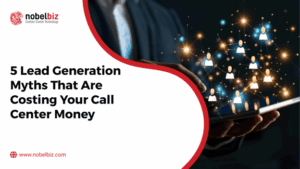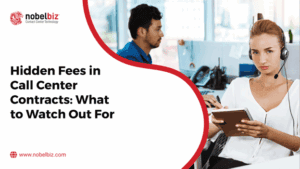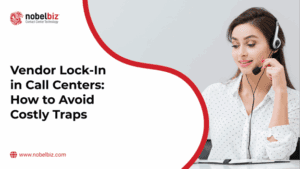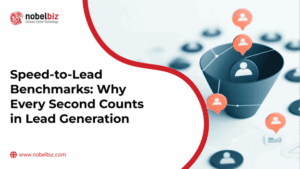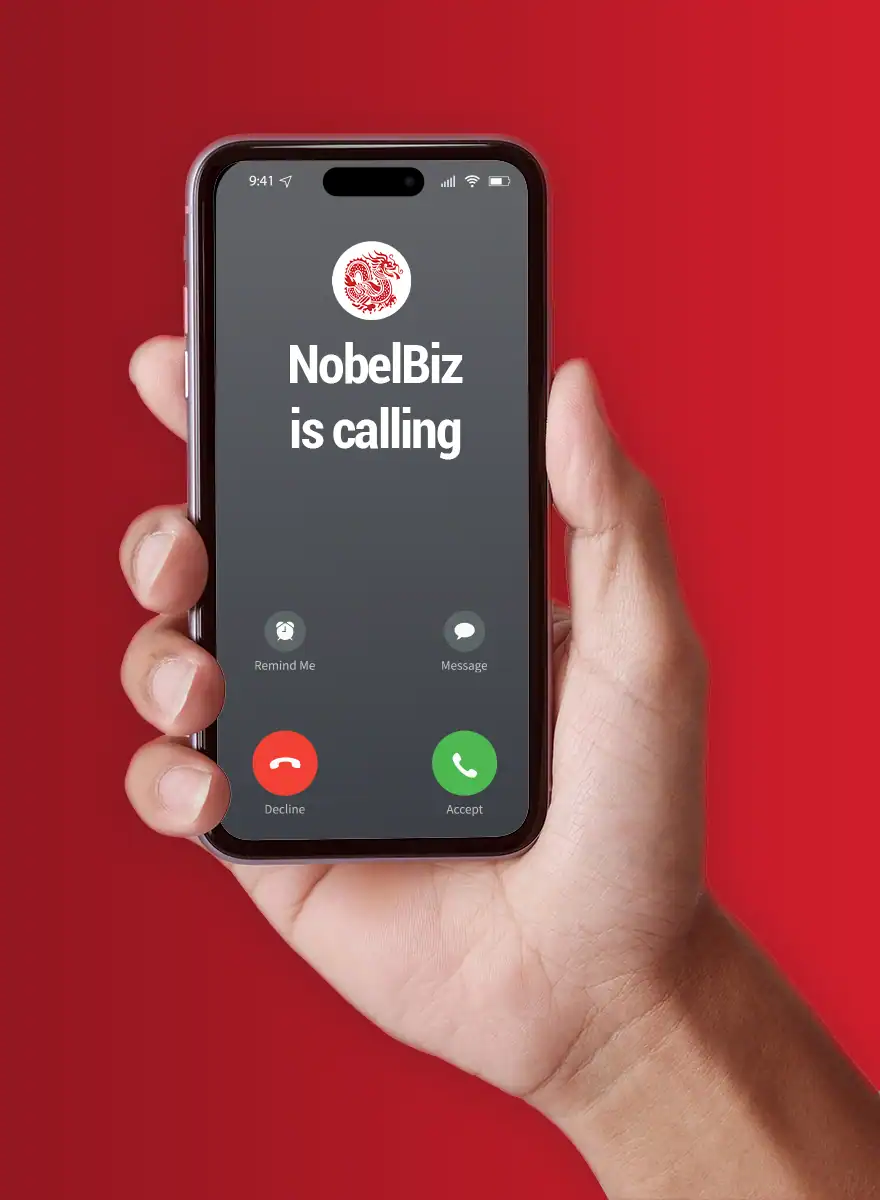Bad leads cost more than money—they cost growth.
In fact, invalid traffic and mis-clicks alone wasted about $72 billion in ad spend in 2024. These contacts never convert, yet they drain sales productivity, inflate acquisition costs, and weaken revenue pipelines.
In call centers, low-quality leads hit even harder: every outbound attempt to an invalid or uninterested number consumes agent time, increases handle time, and skews metrics like cost per contact and connect rate. The result? Wasted effort and measurable loss in operational performance and morale.
The impact goes deeper. Sales teams lose time chasing prospects with no intent to buy. Marketing budgets get tied up in campaigns that deliver volume but not value. Leadership sees pipelines that appear full—but fail to generate predictable revenue.
For call centers, these issues manifest through reduced contact rates, higher abandonment, and ineffective campaign routing. Managers are often forced to reassign or recycle lists, creating more admin work and driving up cost per acquisition (CPA) without improving results.
The real danger is long-term: a steady stream of poor leads erodes sales confidence, skews performance metrics, and lowers customer trust.
Over time, businesses not only lose revenue but also miss chances to build meaningful relationships with buyers who are actually ready to convert.
In contact centers, this erosion shows up as lower agent morale and reduced call quality. Reps spend hours talking to uninterested people—a cycle that hurts productivity, retention, and accuracy in performance reporting. Poor-quality leads also distort campaign data, giving leadership a false sense of success.
This blog explains why low-quality leads harm businesses and how to avoid this common trap. You’ll learn what makes a lead “bad,” where they come from, and how to build strategies that protect ROI, boost sales efficiency, and keep your pipeline healthy in 2025 and beyond.
“We’ve seen too many centers wait for a TCPA violation to start building compliance systems. By then, it’s already cost them hundreds of thousands in fines or lost volume.” – Christian Montes, Chief Operating Officer at NobelBiz
The Essential Traits of Low-Quality Leads and How They Affect Your Sales
Not every lead is a good lead. Some contacts simply won’t convert, no matter how much effort your sales team puts in. These are known as low-quality leads, and understanding their hidden cost is the first step toward improving ROI.
In call centers, these leads directly affect metrics such as call completion rate and conversion-to-contact ratio. Every invalid or unresponsive number adds seconds or minutes of wasted time, multiplying across thousands of daily calls.
A low-quality lead is a contact unlikely to convert into a customer, leading to ongoing sales lead quality issues. These leads typically lack clear interest, budget, authority, or the right fit for your product or service.
When routed through a dialer, these leads consume capacity that could otherwise be directed toward verified, high-intent numbers. Over time, this reduces total outreach efficiency and can even disrupt predictive dialing algorithms.
Pro Tip: The difference between high-quality vs. low-quality leads often comes down to three factors — fit, budget, and intent. Spotting these early prevents wasted effort and boosts ROI.
You can usually identify low-quality leads by noticing one or more of the following red flags:
- Incomplete or fake contact details
- Unresponsive behavior over time
- Low engagement with emails, calls, or ads
- Misaligned needs with your offering
- No clear buying intent
For call centers, these red flags appear through patterns such as repeated no-answers, short call durations, and high rates of disconnected numbers. Recognizing these signals early helps managers adjust campaigns before efficiency drops further.
Salman Aslam
Director Support – Quality & Training at WORK Inc.
‘The support team at Nobelbiz understood our business requirements and we we’re able to push through seamlessly’
What Makes a Lead “Bad” for Sales?
Not every lead in your funnel will turn into a customer, and the cost of bad leads in sales can be seen in wasted time, lost opportunities, and reduced close rates. Some may appear promising on the surface but will ultimately fail to convert, resulting in wasted time and resources. Below are the most common signs of low-quality leads that drain ROI and frustrate both sales and marketing teams.
For call centers, these same symptoms result in inefficient dialing cycles, low connect ratios, and higher operational costs. Unqualified or irrelevant leads force agents to spend more time per successful contact, driving up cost per conversation and lowering morale.
Outside Your Target Industry or Region
Leads that don’t fit your target industry or geography rarely bring value. Sales teams that waste time on unqualified leads from unrelated sectors or locations typically see little to no return on investment. Poor lead targeting in these cases reduces efficiency and makes it more challenging to reach actual buyers.
Call centers experience this as a drop in contact rate and a rise in short-duration calls. Targeting the wrong region or time zone can lead to low answer rates and poor customer experience.
No Budget to Buy
Interest alone is not enough. A lead without a budget cannot move forward, even if they like your solution. Marketing budget wasted on bad leads like these results in inflated pipelines with no real revenue potential. Strong qualification upfront avoids chasing low-intent contacts who cannot pay. This is one of the most common consequences of poor lead generation, where initial interest exists, but the deal cannot move forward.
In call centers, this leads to repetitive, unproductive conversations where agents invest time qualifying prospects who cannot purchase. Over time, that repetitive cycle lowers energy levels and reduces productivity across outbound campaigns.
Lack of Decision-Making Authority
When prospects have no authority to approve purchases, the sales process stalls. Conversations may happen, but deals don’t close until decision-makers are involved. Lead gen vendors selling low-intent contacts often deliver these “non-buyers,” which slows sales cycles and lowers win rates.
For agents, these interactions translate into long talk times with no result. Training agents to identify authority early on helps shorten calls, improve conversion ratio, and increase operational focus.
Poor Fit for the Problem You Solve
Leads who don’t share the problem your product solves are not a good match. Even if they engage in early conversations, they won’t see enough value to convert. Low-quality lead sources that drain ROI often include contacts pulled into campaigns that lack relevance to the solution offered.
For call centers, this results in a high percentage of unqualified calls. Such mismatches lower average talk duration, inflate queue length, and distort campaign analytics.
Entered the Funnel by Mistake
Some leads enter pipelines through irrelevant forms, mistargeted ads, or poorly managed campaigns. These contacts never intended to make a purchase. Chasing them wastes sales resources and highlights data hygiene issues that make pipelines less predictable. Improving filtering at this stage prevents unnecessary effort and preserves sales productivity.
In contact centers, these “mistaken” leads show up as wrong numbers, uninterested parties, or calls that end within seconds. Regular lead cleansing and DNC validation help prevent these occurrences and protect agent efficiency.
Pro Insight: Identifying and filtering these red flags early saves teams hours of wasted effort and ensures your agents focus on high-intent, conversion-ready prospects.
Brayan Carpio
Senior Call Center Manager, Call4You Marketing
‘The technology aspect of NobelBiz stood out compared to the competition, and also the great team! All the way from onboarding to support to troubleshooting has been great throughout this journey!’
Identifying Common Sources of Low-Quality Leads
Many pipelines are filled with contacts that will never convert. Here is a list of some common mistakes that generate poor leads. For call centers, understanding these sources is crucial because every invalid or unqualified contact fed into a dialer affects contact rate, agent occupancy, and compliance performance. Pinpointing the origin of bad data allows managers to maintain cleaner lists, higher productivity, and better ROI across campaigns.
Broad, Untargeted Digital Ads
Ads that reach a broad audience instead of a defined one often attract irrelevant clicks. These campaigns generate traffic and form fills, but the leads don’t align with your ideal customer profile. Sales teams then spend hours sorting through contacts that were never a fit in the first place. When this data reaches a call center, those same irrelevant leads waste hundreds of dialing attempts. Outbound agents are forced to make repeated calls to unresponsive numbers, lowering connect percentages and increasing cost per dial. Targeted advertising doesn’t just protect marketing ROI—it protects the time and focus of every call center agent downstream.
Purchased or Scraped Contact Lists
Buying lists or scraping databases may seem like a fast way to fill the funnel, but it usually backfires. These contacts never gave consent or interest in your offer. As a result, they rarely engage, have lower deliverability rates, and sometimes damage your sender reputation. For call centers, purchased lists are especially risky. Calling individuals without prior consent introduces TCPA compliance issues, potential fines, and reputational damage. It also results in high abandonment rates and low connect ratios. Clean, opt-in data ensures your outbound team operates within regulations and reaches real people who actually want to engage.
Gated Content with Weak Filters
Whitepapers, eBooks, and guides can attract strong leads, but only if the forms are properly qualified. Weak or generic forms attract large volumes of people who only seek free content. These contacts often ignore follow-up sales calls because they had no intent to buy. When call centers receive these types of contacts, agents often experience frustration as call after call leads nowhere. Strengthening filters and intent signals before contacts hit the dialing system helps ensure that every outbound attempt has a genuine opportunity to connect with a qualified prospect.
Misaligned Lead Generation Vendors
Third-party vendors often prioritize meeting lead quotas over delivering quality. This can flood your CRM with names that don’t fit your target industry, budget, or decision-making role. While it looks like volume is high, the reality is poor conversion and wasted spend. Call centers relying on vendor-supplied leads face similar pitfalls. Agents end up dialing unverified or recycled numbers, producing lower connect rates and wasted talk time. Establishing clear vendor SLAs and auditing lead accuracy protects not just budget but also agent productivity.
Social Media Contests or Giveaways
Contests bring attention and sign-ups quickly, but they attract people chasing prizes rather than solutions. These contacts have low intent and rarely convert leads into real opportunities. Relying on this method clogs your pipeline with leads that add no long-term value. For call centers, these types of lists result in disconnected calls, high no-answer rates, and an overall drop in performance metrics. Agents become fatigued chasing non-buyers, and campaign costs rise without revenue return. Eliminating these low-intent sources maintains a healthier dialing list and ensures agents focus on qualified prospects.
Pro Insight: Understanding the origin of your bad leads allows you to fix the problem at its source, reduce waste, and improve campaign ROI across every channel.
Related article:
The Hidden Cost of Low-Quality Leads: What You Need to Know
Low-quality leads drain your resources and impact your bottom line. Here’s a concise breakdown of how poor lead quality affects your business:
| Impact | Example | Statistic |
|---|---|---|
| Wasted Sales Time | SDRs chasing unqualified prospects | Sales reps spend ~25% of their time on bad lead qualification. |
| Inflated Customer Acquisition Cost (CAC) | Marketing budget spent on the wrong audience | 61% of marketers waste at least 25% of their budget on bad leads. |
| Lost Opportunity | Strategic decisions based on insufficient data | Organizations lose approximately $12.9 million annually due to poor-quality B2B data. |
| Massive Revenue Leak | Data decay, inaccurate leads | Poor data quality can result in a loss of up to 25% of potential revenue. |
| Broad Economic Cost | Economy-wide impact | Poor data quality in the U.S. costs ~$3.1 trillion annually. |
Low-quality leads are more than a pipeline problem. They represent the hidden cost of poor leads, draining budgets, and limiting sales potential. Below are the primary areas where businesses incur the most significant losses.
Insight: Low-quality leads don’t just waste money—they distort forecasting accuracy, lower morale, and erode long-term revenue growth.
Clinical Trial Media
Mo Pene |
Contact Center Technology Manager @ CTM
‘Thanks to NobelBiz, we now enjoy a robust, scalable communication system tailored to our growing needs, empowering us to deliver personalized care experiences more efficiently and boosting our overall revenue.’
The Annual Cost of Low-Quality Leads to Businesses
For leadership teams, the big question remains: how much do low-quality leads cost businesses? The answer often runs into millions annually. The financial impact is staggering. Gartner estimates that companies lose $12.9 million annually because of poor-quality leads. These losses come from wasted sales efforts, missed revenue opportunities, and misdirected marketing spend.
When those same poor-quality leads are funneled into a call center, the financial impact compounds. Agents spend their shifts reaching non-viable numbers or talking to unqualified contacts, driving up cost per acquisition while lowering overall conversion rates. These inefficiencies can silently consume a significant percentage of a call center’s total operating budget.
Data Insight: Recent research by Experian plc shows that bad leads can account for up to 25% of potential revenue. This means one out of every four dollars a business could earn never materializes.
The reason is simple. Representatives spend time on the wrong people instead of focusing on qualified buyers who are ready to make a purchase.
Insight: The numbers make it clear — even with strong sales processes, low-quality leads keep revenue growth well below its potential.
The Impact on Sales Productivity and SDR Morale
Bad leads don’t just affect revenue; they wear down your sales team. DemandExchange reports that reps spend 25% of their time working on unqualified or bad leads . That’s a quarter of their effort spent on conversations that will never close.
Productivity Insight: Every minute wasted on poor-quality leads means fewer qualified calls, fewer pipeline opportunities, and slower revenue growth.
This time drain lowers overall productivity. Fewer qualified calls mean fewer opportunities in the pipeline. The issue also damages morale. SDRs and sales reps quickly notice when most of their work ends in dead ends. Over time, this leads to frustration, disengagement, and even higher turnover. For contact centers, the cost of replacing and retraining agents adds another layer of expense to already strained operations. Maintaining lead quality protects not only revenue but also workforce stability.
For businesses, the hidden cost isn’t just lost deals—it’s the expense of replacing burned-out reps and rebuilding sales momentum. Call centers that implement lead verification and prioritization tools can significantly improve morale by ensuring agents consistently reach real, engaged prospects. When conversations are meaningful, performance improves naturally.
“Fewer, higher-quality leads don’t just improve sales outcomes — they protect your reputation, your team’s morale, and your bottom line.” – Christian Montes, Chief Operating Officer at NobelBiz
Wasted Marketing Budgets on Bad Data
Marketing teams face the same challenge. According to DemandExchange, 61% of marketers admit to wasting at least 25% of their budgets on poor-quality leads . This often comes from untargeted campaigns, inaccurate contact lists, and weak qualification methods. When these leads enter a call center, the impact becomes visible almost instantly: inflated dial lists, high drop-off rates, and poor contact outcomes. Even advanced dialers cannot compensate for fundamentally bad data.
Marketing Insight: Poor data integrity not only wastes ad spend but also slows campaign optimization and reduces ROI across all outbound efforts.
When a significant portion of ad spend or lead-gen investment is directed toward the wrong audience, the result is poor ROI. Campaigns may generate volume, but they don’t deliver sales-ready prospects. The marketing funnel fills with noise, forcing sales teams to spend even more time filtering out unqualified contacts. In outbound call centers, this creates longer campaign cycles and decreased talk-to-lead ratios. Marketing and operations must work closely to ensure that only verified, relevant leads flow into the dialing systems.
Insight: This cycle of wasted budget reduces efficiency across both marketing and sales. In competitive industries, it also makes it harder to justify campaign spend. Call center leaders can break the pattern with stronger list hygiene, verification software, and tighter data alignment between marketing and operations.
The Long-Term Brand and Deliverability Risks
The risks of low-quality leads go beyond immediate revenue or budget waste. Poor data has long-term consequences for brand reputation. According to recent research, reports that insufficient data costs the U.S. economy around $3.1 trillion annually . For call centers, brand damage often appears in the form of blocked or flagged numbers. When agents make repeated calls to invalid or uninterested contacts, carriers may categorize your numbers as spam, drastically lowering connect rates and campaign effectiveness.
Deliverability Tip: Consistent calls to invalid or uninterested contacts can lead carriers to flag your numbers as spam, dramatically reducing connect rates and damaging campaign results.
At the company level, this often shows up as email deliverability issues. Sending messages to invalid or unqualified contacts lowers sender scores, increases spam complaints, and damages domain reputation. Once deliverability suffers, even campaigns targeting high-quality leads may fail to reach inboxes. Similarly, for voice channels, reputation scoring applies to outbound caller IDs. Once a number is flagged by carriers, even legitimate calls to qualified leads can go unanswered. Maintaining clean lead data directly supports your call center’s reputation and ensures calls reach real prospects.
Insight: Brand trust also takes a hit when customers feel bombarded by irrelevant outreach. Once associated with spam, rebuilding that trust takes significant time and investment.
Essential Factors Contributing to Poor Lead Quality in Businesses
Many companies face ongoing issues with the quality of their sales leads due to how they source, define, and manage leads. Below are the most common reasons this problem continues.

1. Buying Cheap Lead Lists
Cheap lead lists may seem like a quick way to fill the pipeline, but they rarely deliver the desired results. These lists often contain outdated, incomplete, or inaccurate data. Many of the contacts never agreed to be contacted in the first place, resulting in very low engagement rates. In call centers, these lists are a major liability. Cheap data often includes disconnected numbers, duplicate entries, or contacts that have been sold multiple times. Dialing from these lists not only wastes agent time but also raises red flags with carriers and regulators, increasing the risk of blocked numbers and TCPA violations.
Example: A company buying a bulk list of 10,000 contacts may find that half the emails bounce, and most of the remaining leads are outside their target industry. Sales teams then spend weeks chasing names that will never convert — resulting in wasted time, wasted money, and frustrated sales reps.
2. Misaligned Marketing and Sales Definitions of a Qualified Lead
Another common problem is when marketing and sales do not agree on what makes a lead “qualified.” Marketing teams may pass leads who simply filled out a form, while sales expects leads who are budget-ready decision-makers. This mismatch causes friction and inefficiency between departments, leading to wasted effort and frustration.
Alignment Tip: When marketing and sales define “qualified leads” differently, both teams suffer. Shared qualification criteria ensure consistency, better targeting, and higher close rates.
3. Lack of Lead Scoring and Data Hygiene
Without lead scoring, all leads are treated the same. This forces sales reps to waste time sorting good prospects from bad ones. A lack of data hygiene exacerbates the problem. Duplicate records, missing details, and incorrect contact information make it harder to prioritize leads. For call centers, data hygiene is more than just a marketing concept — it’s an operational necessity. Duplicate or incomplete records create repetitive calls, poor customer experience, and inaccurate reporting. A strong hygiene process ensures agents only reach valid, verified contacts and that each dial contributes meaningfully to revenue.
Pro Tip: Regular data cleaning and a clear lead scoring model ensure reps know precisely who to prioritize and why — boosting efficiency and ROI.
How to Identify Low-Quality Leads Early: Spotting Red Flags in Your Pipeline

Capturing low-quality leads at the outset is crucial. Here is how to identify low-quality leads early and prevent wasted pipeline effort and budget loss. For call centers, early detection means more than just filtering lists—it protects compliance, agent performance, and dialing reputation. Recognizing low-quality data before upload saves time, reduces cost per call, and ensures agents connect with legitimate, engaged prospects.
Identify Red Flags in Lead Gen Campaigns
Specific patterns emerge when campaigns generate poor leads. Common red flags include incomplete forms, fake email addresses, and unusually high volumes of sign-ups from a single campaign with low engagement later. In call centers, these issues manifest as high no-answer rates, short call durations, and increased call attempts per conversion. Monitoring these metrics can help supervisors identify problematic campaigns or sources before they compromise overall performance.
Watch for patterns: A sudden spike in form fills with low engagement is often the first warning sign of poor lead quality.
Measure Lead Quality with Scoring Models
Lead scoring assigns points based on how closely a prospect matches your ideal customer profile and their behavior. Criteria may include company size, job title, industry, website visits, or email activity.
Example: A lead who matches your target industry, visits your pricing page, and attends a webinar should score higher than one who only signs up for a generic email.
A structured model ensures sales teams spend time on leads most likely to buy. When combined with call analytics, scoring ensures lists are loaded into dialers in optimal sequence, improving talk time utilization and agent morale.
Use Intent Signals and Enrichment to Weed Out Bad Leads
Intent data shows if a lead is actively researching solutions like yours. Enrichment tools add missing details such as company size, revenue, or role, which helps confirm if the lead fits your market.
Example: A contact downloading multiple comparison guides on CRM platforms signals real buying intent — while missing company data often indicates a poor fit.
Combining intent signals with enriched data enables businesses to filter out weak leads early and focus solely on strong opportunities. By removing poor-quality contacts before they reach the dialing stage, call centers can save hundreds of hours of wasted outreach while increasing conversion efficiency.
Proven Strategies to Avoid Low-Quality Leads in 2025

Avoiding poor-quality leads requires a structured approach. Below are proven strategies to help businesses prevent low-quality leads in 2025 and improve sales efficiency. For call centers, these same strategies directly enhance dialing accuracy, agent efficiency, and compliance integrity. Implementing them ensures that campaigns deliver higher ROI without sacrificing operational control or customer trust.
Build an Ideal Customer Profile (ICP)
An ICP defines the exact type of customer for whom your product or service is best suited. It includes factors such as company size, industry, location, revenue, and role within the organization. In a call center, a detailed ICP guides list segmentation and dialing strategy. Campaigns targeted around precise ICPs see higher connection quality, fewer wasted calls, and better conversation outcomes.
Pro Tip: A well-documented ICP prevents marketing campaigns from attracting unqualified prospects and ensures all outreach focuses on high-fit, purchase-ready accounts.
When combined with smart routing, ICP criteria can also help assign calls to agents with the right expertise, improving conversion performance.
Align Marketing and Sales on Qualification Criteria
When marketing and sales use different definitions of a qualified lead, low-quality prospects enter the funnel. Setting shared criteria for qualification is essential. This usually covers budget, authority, need, and timeline.
Team Alignment Insight: When both teams follow the same framework, lead handoffs are smoother and sales teams spend less time chasing unqualified prospects.
For agents, that means fewer dead-end conversations and a more consistent flow of high-quality contacts throughout the day.
Invest in Better Targeting and Data Sources
Low-quality leads often come from poor or inaccurate data. Using reliable data providers and more effective targeting filters can help mitigate this issue. Clean, updated, and segmented data ensures leads are real, relevant, and reachable. For call centers, verified data directly improves connect rates and lowers complaint risk. Using trusted data sources also protects caller ID reputation and supports long-term deliverability.
Data Insight: Precise targeting increases the likelihood of connecting with true decision-makers and reduces wasted time on irrelevant contacts.
Utilize AI Tools to Detect and Filter Poor Leads
AI-driven tools analyze engagement and behavioral patterns to distinguish between strong and weak leads. These tools can validate data, detect fake information, and highlight intent signals. Automated filtering removes contacts that are unlikely to convert before they reach sales teams. Real-time analysis also enables businesses to prioritize high-quality leads more efficiently. AI ensures that lead pipelines remain efficient, accurate, and productive. For call centers, these tools can be connected directly to dialer systems, automatically suppressing invalid or non-consented contacts. The result is cleaner campaigns, higher answer rates, and better compliance performance.
AI Advantage: Automating lead validation and filtering protects compliance, increases accuracy, and helps teams focus only on the highest-value prospects.
Real-World Impact and Case Study: Leading Edge Connections
Leading Edge Connections faced low contact rates and weak reporting that strained margins and teams. After switching to NobelBiz Omni+, they reduced poor-fit interactions and improved call results. Their agent teams engaged more qualified contacts, leading to better ROI and more efficient operations. This resulted in:
1.5M+
Customer Interactions / Month
2
New Clients in 2 Years
10%
Lower Cost to Acquire
97%
Customer Satisfaction Score
Key Takeaway: When companies chase volume instead of quality, the adverse effects emerge swiftly — lower conversion rates, wasted resources, and weakened brand trust.
“Fewer, higher-quality leads don’t just improve sales outcomes — they protect your reputation, your team’s morale, and your bottom line.” – Christian Montes, Chief Operating Officer at NobelBiz
Final Thoughts: Why Lead Quality Beats Lead Quantity
Focusing on lead quality rather than lead volume helps businesses protect budgets, improve sales efficiency, and build long-term growth. More leads do not always mean more revenue. The real value lies in connecting with the right prospects at the right time. For call centers, this principle defines success. A smaller list of verified, compliant, and high-intent leads consistently delivers better conversion rates and call outcomes than high-volume, low-quality data ever could.
Large volumes of unqualified leads quickly drain resources. Sales teams waste hours on conversations that will never result in a conversion. Marketing budgets are often consumed by campaigns that generate numbers but fail to deliver results. This creates a cycle where quantity masks performance issues, while actual ROI declines.
Key Insight: Quality leads shorten sales cycles, improve close rates, and reduce acquisition costs — directly boosting both ROI and morale.
Clear qualification criteria ensure that only leads with real potential move through the funnel. This reduces wasted outreach and shortens sales cycles. Sales representatives spend more time with decision-makers who have budget and intent, improving close rates and revenue. Companies also reduce acquisition costs by focusing on leads most likely to convert. For call centers, this directly translates to fewer wasted calls, better compliance outcomes, and stronger overall agent performance.
Regulations such as TCPA and stricter data privacy laws make call center compliance non-negotiable. Non-compliance risks penalties, damaged reputation, and lost trust. A compliance-first approach ensures outreach is lawful and trusted. Combining this with targeted lead generation, built on accurate data and intent signals, enables businesses to scale safely, sustain deliverability, and protect their brand credibility.
Frequently Asked Questions
Discover how NobelBiz helps call centers maximize customer engagement, boost answer rates, and ensure compliance with industry-leading solutions.

Michael McGuire is a contact center industry expert with almost two decades of experience in the space. His experience includes roles as Director of Contact Center Digital Transformation at NobelBiz, and as Director of Operations at FLS Connect, managing multiple call centers. As President of Anomaly Squared and Targeted Metrics, Michael successfully transitioned companies into remote operations and significantly boosted revenues. With a strong background in customer service, leadership, strategic planning, and operations management, Michael excels in driving growth and innovation in the call center space.
Mike is also a proud Board Member for R.E.A.C.H Trade Group, promoting consumer protection and satisfaction and Co-host of the Off Skripted Podcast – a show about Life, Call Centers and everything in between.





